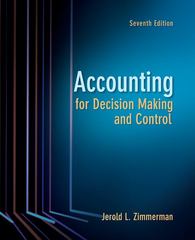Discretionary costs are defined as costs that (1) arise from periodic (usually yearly) appropriation decisions regarding the
Question:
Discretionary costs are defined as “costs that (1) arise from periodic (usually yearly) appropriation decisions regarding the maximum amounts to be incurred and (2) have no well-specified function relating inputs (as measured by the costs) and outputs (as measured by revenue or other objectives such as students’ knowledge or patients’ health). Examples include advertising, public relations, executive training, teaching, research, health care, and management consulting services. The most noteworthy aspect of discretionary costs is that one is seldom confident that the ‘correct’ amount is being spent.”17 Discretionary cost centers are those parts of the organization that have large discretionary costs.
Such subunits of the organization tend to have a high percentage of their costs in human resources performing nonrepetitive and nonroutine functions whose principal output is information-/serviceoriented.
The value of the output from discretionary cost centers is difficult to determine, as is the quality. Examples of discretionary cost centers include R&D, legal, public relations, and internal consulting organizations.
Max Jarvis, corporate controller for a midsize steel company, has just attended a seminar on discretionary cost centers. He decides to adopt this approach in budgeting and controlling several corporate headquarters departments, including market research and environmental protection. These departments are currently cost centers.
Required:
a. How do discretionary cost centers differ from cost centers and profit centers?
b. What changes do you expect Max Jarvis’s adoption of discretionary cost centers to produce?
Step by Step Answer:

Accounting For Decision Making And Control
ISBN: 9780078136726
7th Edition
Authors: Jerold Zimmerman





